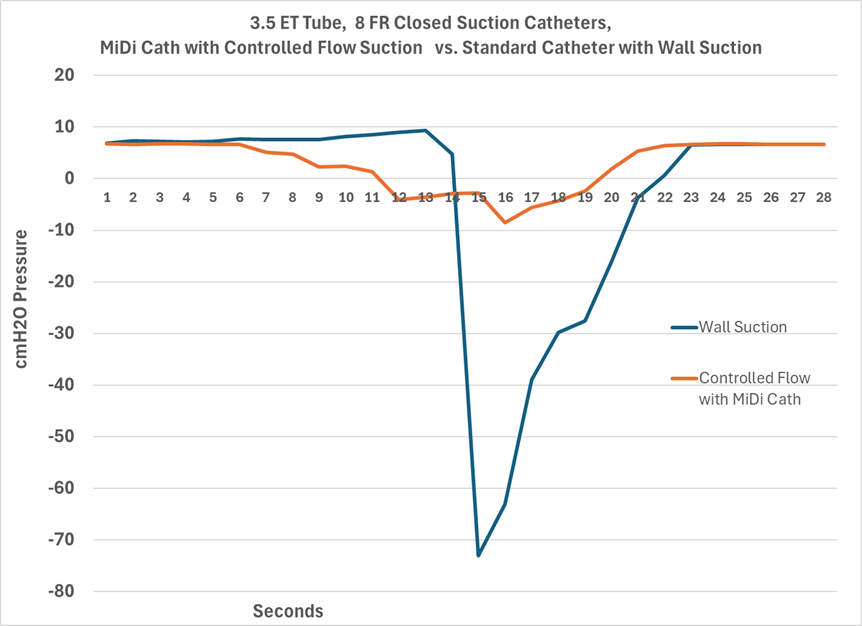The Science Behind Controlled Flow Suction
The EXSALTA Suction Pump extracts secretions at a controlled low flow to preserve the positive pressure (FRC) in the lungs. Ordinary systems do not control suction flow and unnecessarily extract the air from the lungs. With ordinary systems, the suction pressure and the size of the suction catheter determine the flow. Exsalta precisely controls suction pressures and flow rates independently, allowing you to increase suction pressure without increasing flow.
How It Works: The Peristaltic Pump Advantage
Exsalta uses a peristaltic pump programed to generate the suction flow rate of ~1.4 – 0.8 l/min. depending on the circuit installed. The user selects a suction pressure from 60 to 300 mmHg, and the pump flow rates remain at 1.4 – 0.8 l/min. The controlled flowrate applies to both liquids and air. Controlling suction flow and suction pressure separately is only available with this type of pump.
Why Controlled Low Flow Suction is Sufficient for Secretion Removal
It takes a full minute to suction a liter of water through a 14 FR catheter at normal suction pressures. Therefore 1 l/min flow rate is enough for pulling secretions through a catheter, and when the catheter clears of secretions the pump suctions air at the same low flow. There is no free flow of air from the lungs with Exsalta Suction. Below is a chart that shows the free flow of air when suctioning with ordinary suction.
| Free flow of air through suction catheters without secretions when using wall suction | Controlled Flow | |||
|---|---|---|---|---|
| Suction Catheter Sizes | Flow Rate at 90 mmHg Reg Suction |
Flow Rate at 110 mmHg Reg Suction |
Flow Rate at 120 mmHg Reg Suction |
Flow Rate at 60-300 mmHg Exsalta Suction |
| 6.0 FR | 3.5 L/min | 4 L/min | 4.2 L/min | ~0.8 – 1.4 L/min |
| 8.0 FR | 7 L/min | 7.6 L/min | 8 L/min | ~0.8 – 1.4 L/min |
| 10.0 FR | 10.2 L/min | 12 L/min | 13 L/min | ~0.8 – 1.4 L/min |
| 12.0 FR | 20.2 L/min | 23.1 L/min | 24 L/min | ~0.8 – 1.4 L/min |
| 14.0 FR | 23 L/min | >24 L/min | >24 L/min | ~0.8 – 1.4 L/min |
Suctioning air is the source of negative pressures in the lungs. Negative pressure causes alveolar collapse, airway collapse, desaturation, and bradycardia. This happens when suctioning removes more air than the ventilator replaces. It varies depending on the ventilator and the interaction between the catheter and secretions.
The graph below is from bench testing and shows the difference between ordinary suction with standard closed suction catheters and controlled flow suction with the BiDi Cath when clearing secretions from an ET Tube in a simulated model. A CPAP of 6 cmH2O was connected to the closed suction catheter to help maintain pressure in the model during the procedure.

With EXSALTA’S controlled Low Flow, secretions are effectively removed while protecting the patient from unnecessary negative pressure.
See It in Action
Watch our video demonstration to visualize the impact of uncontrolled air extraction and how EXSALTA’s Low Flow Smart Suction allows the ventilator on CPAP maintain positive pressure.
Please note: The ET Tube in the video is without secretions and demonstrates free flow. In actual use, free flow is only active when the catheter is cleared of secretions, and this varies greatly from procedure to procedure.
